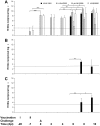Efficacy of influenza vaccination and tamiflu® treatment--comparative studies with Eurasian Swine influenza viruses in pigs
- PMID: 23630601
- PMCID: PMC3632577
- DOI: 10.1371/journal.pone.0061597
Efficacy of influenza vaccination and tamiflu® treatment--comparative studies with Eurasian Swine influenza viruses in pigs
Abstract
Recent epidemiological developments demonstrated that gene segments of swine influenza A viruses can account for antigenic changes as well as reduced drug susceptibility of pandemic influenza A viruses. This raises questions about the efficacy of preventive measures against swine influenza A viruses. Here, the protective effect of vaccination was compared with that of prophylactic Tamiflu® treatment against two Eurasian swine influenza A viruses. 11-week-old pigs were infected by aerosol nebulisation with high doses of influenza virus A/swine/Potsdam/15/1981 (H1N1/1981, heterologous challenge to H1N1 vaccine strain) and A/swine/Bakum/1832/2000 (H1N2/2000, homologous challenge to H1N2 vaccine strain) in two independent trials. In each trial (i) 10 pigs were vaccinated twice with a trivalent vaccine (RESPIPORC® FLU3; 28 and 7 days before infection), (ii) another 10 pigs received 150 mg/day of Tamiflu® for 5 days starting 12 h before infection, and (iii) 12 virus-infected pigs were left unvaccinated and untreated and served as controls. Both viruses replicated efficiently in porcine respiratory organs causing influenza with fever, dyspnoea, and pneumonia. Tamiflu® treatment as well as vaccination prevented clinical signs and significantly reduced virus shedding. Whereas after homologous challenge with H1N2/2000 no infectious virus in lung and hardly any lung inflammation were detected, the virus titre was not and the lung pathology was only partially reduced in H1N1/1981, heterologous challenged pigs. Tamiflu® application did not affect these study parameters. In conclusion, all tested preventive measures provided protection against disease. Vaccination additionally prevented virus replication and histopathological changes in the lung of homologous challenged pigs.
Conflict of interest statement
Figures





References
-
- WHO (2009) Influenza (Seasonal).
-
- Palese P (2004) Influenza: old and new threats. Nat Med 10: S82–87. - PubMed
-
- Wright PF, Neumann G, Kawaoka Y (2007) Orthomyxoviruses. In: Knipe DM, Howley PM, editors. Fields Virology. Philadelphia, PA, 19106 USA: Lippincott Williams & Wilkins. pp. 1692–1740.
-
- Kuntz-Simon G, Madec F (2009) Genetic and antigenic evolution of swine influenza viruses in Europe and evaluation of their zoonotic potential. Zoonoses Public Health 56: 310–325. - PubMed
-
- Schrader C, Suess J (2003) Genetic characterization of a porcine H1N2 influenza virus strain isolated in Germany. Intervirology 46: 66–70. - PubMed
Publication types
MeSH terms
Substances
LinkOut - more resources
Full Text Sources
Other Literature Sources
Medical

